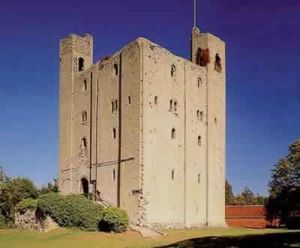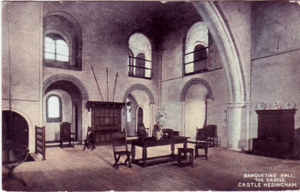| Magna Carta Surety Baron Robert de Vere was one of the twenty-five medieval barons who were surety for Magna Carta in 1215. Join: Magna Carta Project Discuss: magna_carta |
Contents |
Biography
Robert de Vere was 3rd Earl of Oxford, hereditary Master Chamberlain and one of the Surety Barons for the Magna Carta.[1][2][3]
Birth and Origins
Robert was the son of Aubrey de Vere and Agnes, daughter of Henry de Essex.[1][2][3] His birth date is uncertain but may have been after 1164.[1][2] Frederick Lewis Weis gives a baptism year of 1164 but there appears to be no good evidence for this.[4]
Marriage and Children
After 1206, Robert de Vere married Isabel de Bolebec, daughter of Hugh Bolbec and wife, and widow of Henry de Nonant.[1][2][5] Robert paid the Crown at least part of a fine for the marriage (as she was a widow, King John had the right to determine her marriage).[3] Robert and Isabel had at least two children:
- Hugh (who married Hawise de Quincy)[1][2][3][5]
- Eleanor (who married Ralph Gernon)[2][5](See Research Notes below.)
Through his wife, Robert held half of the Barony of Whitchurch, based in Buckinghamshire.[3][6]
Life
Little is known of Robert's life before his marriage, apart from witnessing charters.[3]
1214 he witnessed a letter in which King John promised free elections to episcopal sees and abbacies.[1] In October that year he succeeded to the lands of his brother Aubrey[2][3], paying 1000 marks to King John for this and a wardship[1][3], but King John seems to have held back the title of Earl of Oxford: in January 1215 Robert witnessed a royal charter with his name but no title of Earl.[3] Robert's inheritance included the Barony of Hedingham, based in Essex.[7]
In the spring of 1215 he was one of the main participants in the rebellion against King John, and, when the Magna Carta was issued, he was one of the Surety Barons.[1][2][3] Within a few weeks he finally had royal recognition of his right to be Earl of Oxford.[3] In December 1215, along with other rebel barons, he was excommunicated.[1][2][3] In March 1216 King John's forces captured his castle at Hedingham.[1][3] Following this Robert swore allegiance to John[1][3], but this did not stop him being one of the barons who continued in rebellion and gave allegiance to Louis of France later in the year.[1][3]
Robert finally returned to allegiance to the English Crown in October 1217.[1][2][3] His lands were restored.[3] In 1220 he was an itinerant justice in Herefordshire[1][2][3] and he was a judge in the royal court at Westminster the next year.[1][3]
Death
Robert died before 25 October 1221 and was buried at Hatfield Priory, Essex.[1][2][3] After the Dissolution of the Monasteries, his effigy was transferred to the parish church of Hatfield Broad Oak.[3]
Research Notes
Alleged Daughter Eleanor
Robert has previously been shown on WikiTree as father of Eleanor, wife of Ralph Gernon. No reliable evidence has been found for this.
The Oxford Dictionary of National Biography states that Robert de Vere and Isabel de Bolebec had just one child, Hugh.[3] The author of that entry has posted on Eleanor's profile that she has found no evidence that they had a daughter called Eleanor, or a child who married Ralph Gernon.
Douglas Richardson[2][8] and Medlands[5] both state that they also had a daughter Eleanor, who married Ralph Gernon. They cite Farrer's Honors and Knights' Fees, which states that "Sir Ralph [Gernon] was twice married, his first wife being Eleanor daughter of Robert de Vere, earl of Oxford..."[9] The citation given by Farrer is a Gernon pedigree in the 1899 volume of Collections for a History of Staffordshire which shows Ralph Gernon married first to "Eleanor dau. of Robert de Vere, Earl of Oxford" and second to "Hawisia (Tregoz)."[10] No source is given for this information, and it cannot be regarded as reliable.
A Gernon pedigree in William Farrer's Feudal Cambridgeshire does not identify the first wife of Ralph Gernon.[11]
Against this background, Eleanor was detached as daughter.
Other Disputed Children
Lacking sources, the following profiles were detached as children:
- Robert de Vere (1208-1250)
- Alice (de Vere) Pomeroy (1186-1206)
Magna Carta 800th Anniversary Biography
For the 800th anniversary of the Magna Carta in 2015, Professor Nigel Saul wrote a set of biographies of the Surety Barons. He and the Magna Carta 800th Anniversary Committee generously gave permission for them to be reproduced on WikiTree. They can be viewed here.
Sources
- ↑ 1.00 1.01 1.02 1.03 1.04 1.05 1.06 1.07 1.08 1.09 1.10 1.11 1.12 1.13 1.14 1.15 G E Cokayne. The Complete Peerage, revised edition, Vol. X, St Catherine Press, 1945, pp. 210-213, OXFORD III
- ↑ 2.00 2.01 2.02 2.03 2.04 2.05 2.06 2.07 2.08 2.09 2.10 2.11 2.12 Douglas Richardson. Magna Carta Ancestry: A Study in Colonial and Medieval Families, 4 vols, ed. Kimball G. Everingham, 2nd edition (Salt Lake City: the author, 2011), Vol. IV, pp. 261-263, VERE 1
- ↑ 3.00 3.01 3.02 3.03 3.04 3.05 3.06 3.07 3.08 3.09 3.10 3.11 3.12 3.13 3.14 3.15 3.16 3.17 3.18 3.19 3.20 3.21 Oxford Dictionary of National Biography, entry for 'Vere, Robert de, third earl of Oxford', print and online 2004, revised online 2005, available online via some libraries
- ↑ Frederick Lewis Weis. Ancestral Roots of Certain American Colonists who came to America before 1700, 8th edition, genealogical Publishing Company, 2004, p. 222, line 246.27
- ↑ 5.0 5.1 5.2 5.3 Charles Cawley. England, Earls created 1138-1143, Chapter 9, Oxford: A. EARLS of OXFORD 1142-1526 (VERE) 2.c.iii., entry for Robert de Vere, in "Medieval Lands": A prosopography of medieval European noble and royal families © by Charles Cawley, hosted by Foundation for Medieval Genealogy (FMG). See also WikiTree's source page for MedLands.
- ↑ I J Sanders. English Baronies, a Study of their Origins and descent 1086-1327. Clarendon Press, Oxford, 1963, p. 98
- ↑ I J Sanders, English Baronies, p. 52
- ↑ Douglas Richardson, Magna Carta Ancestry, Vol. III, p. 350, PEYTON 2
- ↑ William Farrer. Honors and Knights' Fees, Vol. III, Manchester University Press/Longmans, Green & Co, 1925, p. 205
- ↑ Falconer Madan (compiler). The Gresleys of Drakelowe, Collections for a History of Staffordshire, New Series, Vol. I, William Salt Archaeological Society, 1899, p. 257, Internet Archive
- ↑ William Farrer. Feudal Cambridgeshire, Cambridge University Press, 1920, p. 218, Internet Archive
- G E Cokayne. The Complete Peerage, revised edition, Vol. X, St Catherine Press, 1945, pp. 210-213, OXFORD III
- Douglas Richardson. Magna Carta Ancestry: A Study in Colonial and Medieval Families, 4 vols, ed. Kimball G. Everingham, 2nd edition (Salt Lake City: the author, 2011), Vol. IV, pp. 261-263, VERE 1. See also WikiTree's source page for ‘’Magna Carta Ancestry.’’
- Douglas Richardson. Royal Ancestry: A Study in Colonial and Medieval Families, 5 vols, ed. Kimball G. Everingham. Salt Lake City: the author, 2013, pp. 251-253. See also WikiTree's source page for ‘’Royal Ancestry’’.
- Charles Cawley. Medieval Lands, entry for 'Robert de Vere (-before 25 Oct 1221)
- Dictionary of National Biography, Vol. 58, London, Smith, Elder & Co., 1899, p. 243, entry for 'Vere, Robert de (1170?-1221)', Wikisource
- Wikipedia: Robert de Vere, 3rd Earl of Oxford
- Our Royal, Titled, Noble, and Commoner Ancestors & Cousins, database online, entry for Robert de Vere, Magna Carta Surety, Compiler: Mr. Marlyn Lewis, Portland, OR, 97232, citing Weis and Richardson, Robert de Vere
- 500-Year De Vere Pedigree by the De Vere Society
Acknowledgements
Magna Carta Project
- As a surety baron, Robert de Vere's profile is managed by the Magna Carta Project. See de Vere-309 Descendants for profiles of his descendants that have been improved and categorized by the Magna Carta project and are in a project-approved trail to a Gateway Ancestor. See this index for links to other surety barons and category pages for their descendants. See the project's Base Camp for more information about Magna Carta trails.
- Profile revised for the Magna Carta Project by Michael Cayley, January 2020.
No known carriers of Robert's DNA have taken a DNA test.
Have you taken a DNA test? If so, login to add it. If not, see our friends at Ancestry DNA.
- Robert de Vere is my grandfather need help Feb 15, 2021.
Rejected matches › Hugh de Vere (abt.1210-bef.1263) › Robert de Vere (-bef.1329) › Robert de Vere (-1391) › Robert de Vere (abt.1320-1369) › Robert de Vere (abt.1089-1094) › Robert de Vere (aft.1217-)
Featured Female Poet connections: Robert is 14 degrees from Anne Bradstreet, 27 degrees from Ruth Niland, 31 degrees from Karin Boye, 35 degrees from 照 松平, 18 degrees from Anne Barnard, 25 degrees from Lola Rodríguez de Tió, 26 degrees from Christina Rossetti, 21 degrees from Emily Dickinson, 36 degrees from Nikki Giovanni, 27 degrees from Isabella Crawford, 24 degrees from Mary Gilmore and 23 degrees from Elizabeth MacDonald on our single family tree. Login to find your connection.
Categories: Early Barony of Hedingham | Magna Carta | Surety Barons | House of De Vere







any objection if I remove Alice & Robert as children and edit birth location from Hatfield, Broad Oaks, Essex, England (where he's buried) to be just Essex, England?
Gabrield Ludlow, immigrated in 1694 to New York. He married Sarah Hanmer. They had seven sons, and five daughters.
Wasn't he, (Gabriel Ludlow-97), Magna Carta badged at one time? Robert De_Vere-309 is the 14th great grandfather of Gabriel Ludlow-97.
Thank you!
- He was Christened in 1164. [2][3]
? Source: #S152 Page: 60-28, 246-27 Source: S152 Ancestral Roots of Sixty Colonists Who Came to New England between 1623 and 1650, 6th ed.,Weis, Frederick (Lewis Publication: Genealogical Publishing Co., Inc., Baltimore, Maryland, 1988), Note: RIN#10004
? Source: #S150 Page: X 210-216 Source: S150 The Complete Peerage of England, Scotland, Ireland, Great Britain and the United Kingdom, Vols. I-XII, Cokayne, George Edward, (St. Catherine Press Ltd., London, 1910-1959).
Thanks
Robert de Vere is written "SIR ROBERT DE VERE" by Richardson in Royal Ancestry, Vol V, page 251.
Regardless that there may be more to it than can be covered here, and this era produces conflicting opinions among experts, it is my opinion WikiTree should continue to use "SIR" unless a question in G2G produces changes in the guidelines.